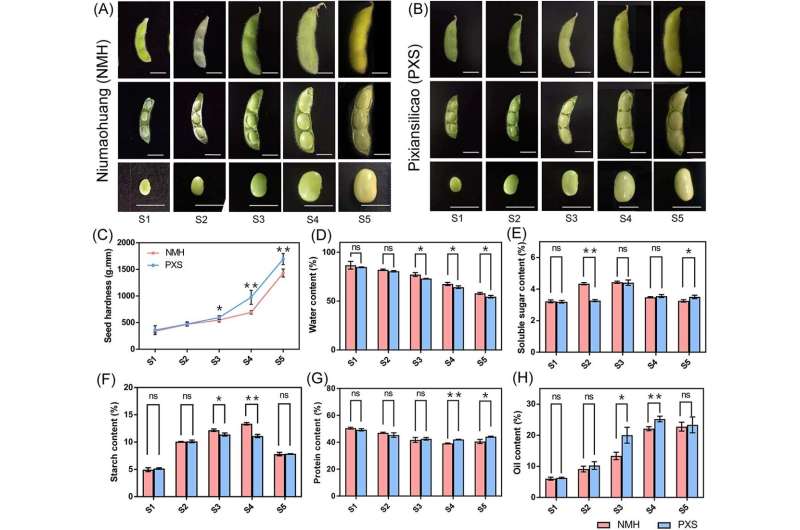This article has been reviewed according to Science X's editorial process and policies. Editors have highlighted the following attributes while ensuring the content's credibility:
fact-checked
peer-reviewed publication
proofread
Soybean seed hardness demystified: Key genes and networks uncovered

Vegetable soybeans are valued for their taste and nutritional benefits, but consumer preferences for seed hardness vary across regions. Chinese consumers prefer softer seeds, while African consumers favor moderately hard seeds.
Despite its importance, research on the factors influencing seed hardness has been limited, especially for vegetable soybeans. Addressing these regional preferences requires an in-depth understanding of the genetic and biochemical mechanisms that determine seed hardness.
Due to these challenges, there is a pressing need for a comprehensive study to enhance soybean quality and marketability.
A collaborative study from Nanjing Agricultural University, published in Horticulture Research, illuminates the genome-wide transcriptome, pinpointing key regulatory networks and genes associated with seed hardness in vegetable soybeans. This research sheds light on the intricate processes that determine soybean seed texture.
The study revealed significant genetic differences between the two soybean landraces during seed development. Key findings include the differential expression of genes involved in starch synthesis, protein storage, and fatty acid metabolism.
The GmSWEET2 gene emerged as a critical regulator of seed hardness; its overexpression in Pixiansilicao led to increased seed hardness, confirming its pivotal role.
Additionally, the study identified stages S3 and S4 of seed development as crucial periods where these genetic differences significantly influenced the accumulation of seed storage components. During these stages, genes involved in cell proliferation and cell wall formation also showed differential expression, impacting seed hardness.
These findings highlight the importance of understanding genetic regulation during specific developmental stages to manipulate seed hardness effectively, providing valuable insights for soybean breeding programs aimed at improving seed texture and quality.
Dr. Han Xing, an author on the study, commented, "Our discovery of the GmSWEET2 gene's role in seed hardness provides valuable insights into soybean breeding. By manipulating this gene, we can develop soybean varieties with tailored seed textures to meet various consumer preferences, enhancing market appeal."
This research paves the way for breeding programs aimed at improving the quality and consumer acceptance of vegetable soybeans. The identification of GmSWEET2 and other key genes offers new targets for genetic modification, allowing for the development of soybean varieties with optimized seed hardness, thus catering to diverse global markets.
More information: Congcong Wang et al, Genome-wide transcriptome analysis reveals key regulatory networks and genes involved in the determination of seed hardness in vegetable soybean, Horticulture Research (2024). DOI: 10.1093/hr/uhae084
Journal information: Horticulture Research
Provided by TranSpread



















